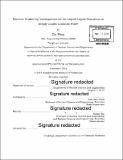| dc.contributor.advisor | Sow-Hsin Chen. | en_US |
| dc.contributor.author | Wang, Zhe | en_US |
| dc.contributor.other | Massachusetts Institute of Technology. Department of Nuclear Science and Engineering. | en_US |
| dc.date.accessioned | 2016-07-18T20:04:00Z | |
| dc.date.available | 2016-07-18T20:04:00Z | |
| dc.date.copyright | 2015 | en_US |
| dc.date.issued | 2015 | en_US |
| dc.identifier.uri | http://hdl.handle.net/1721.1/103720 | |
| dc.description | Thesis: Ph. D., Massachusetts Institute of Technology, Department of Nuclear Science and Engineering, 2015. | en_US |
| dc.description | Cataloged from PDF version of thesis. | en_US |
| dc.description | Includes bibliographical references (pages 93-102). | en_US |
| dc.description.abstract | Water is ubiquitous but mysterious. It exhibits anomalous thermodynamic behaviors at low temperatures. In addition, the glassy water, also called amorphous ice, exhibits polyamorphism. These phenomena could be understood if one accepts that a first-order low-density liquid (LDL) to high-density liquid (HDL) phase transition exists in the deeply cooled region (below 230 K) of water. However, the experimental test on the LDL and HDL in bulk water is practically difficult due to the crystallization below the homogeneous nucleation temperature (~232 K at atm). It is found that, by confining water in a hydrophilic nanoporous material, MCM-41, the homogeneous nucleation process can be avoided, which allows us to keep water in liquid state at least down to 130 K. Therefore, the confined water provides us an opportunity to detect the hypothetical HDL and LDL in the deeply cooled region of water. This thesis is devoted to the detection of the first-order LDL-to-HDL transition in the water confined in MCM-41. In this thesis, the phase behaviors of the deeply cooled water confined in MCM-41 are investigated. With elastic neutron scattering, we measure the average density of the confined water at low temperatures and high pressures. The results show the existence of a first-order LDL-to-HDL transition in such system. The phase separation starts from 1.12 0.17 kbar and 215 1 K and extends to higher pressures and lower temperatures in the phase diagram. This starting point could be the liquid-liquid critical point of the confined water. The locus of the Widom line in the phase diagram is also determined. Parallel to the density measurement, the dynamic properties, including the so-called "boson peak", the librational motion, and the relaxation process of the confined water, are also studied with dynamic neutron scattering. The time scales of these motions cover a broad range from 10-2 picosecond to hundreds of nanoseconds. The results confirm the phase diagram obtained with the density measurement and show that the HDL and LDL differ in the hydrogen-bond strength and the configuration of the local hydrogen-bond network. Combining all the experimental results, we provide a clear evidence for the existence of the LDL and HDL in the confined water. Water is crucial to protein dynamics. We investigate the role water plays in sub-picosecond collective vibration of protein with inelastic X-ray scattering and find that the hydration water makes the intraprotein longitudinal phonons "softer". We also study the slow dynamics of the protein hydration water with quasi-elastic neutron scattering. A hydration-dependent dynamic crossover phenomenon is found. The observation of the liquid-liquid transition in the confined water has potential to explain the mysterious behaviors of water at low temperatures. In addition, it may also have impact on other disciplines, because the confined water system represents many biological and geological systems where water resides in nanoscopic pores or in the vicinity of hydrophilic or hydrophobic surfaces. | en_US |
| dc.description.statementofresponsibility | by Zhe Wang. | en_US |
| dc.format.extent | 102 pages | en_US |
| dc.language.iso | eng | en_US |
| dc.publisher | Massachusetts Institute of Technology | en_US |
| dc.rights | M.I.T. theses are protected by copyright. They may be viewed from this source for any purpose, but reproduction or distribution in any format is prohibited without written permission. See provided URL for inquiries about permission. | en_US |
| dc.rights.uri | http://dspace.mit.edu/handle/1721.1/7582 | en_US |
| dc.subject | Nuclear Science and Engineering. | en_US |
| dc.title | Neutron scattering investigations on the liquid-liquid transition in deeply cooled confined water | en_US |
| dc.type | Thesis | en_US |
| dc.description.degree | Ph. D. | en_US |
| dc.contributor.department | Massachusetts Institute of Technology. Department of Nuclear Science and Engineering | |
| dc.identifier.oclc | 953415646 | en_US |
